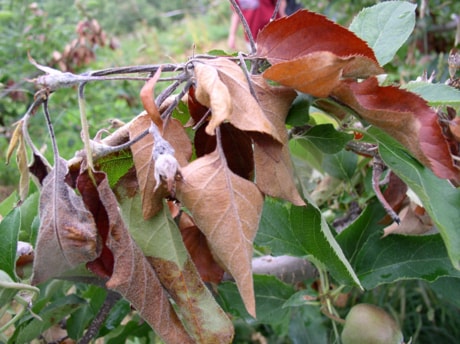Typical Canadians love to complain about the weather.
What they do not realize or like to ignore is the fact that the cold temperatures can be a benefit. Gardeners in Central Alberta have fewer problems with plant diseases than gardeners in milder climates.
Blights, cankers and some mildews are common but definitely do not appear in every garden.
A plant is said to have a blight when leaves, flowers or stems suddenly wither and turn brown.
Infected parts of the plant should be removed immediately, burned or double bagged and placed in the garbage. Cut into new wood when removing diseased plant material.
Dipping the cutting tools in a low bleach solution between cuts will stop the disease from spreading between branches and between plants.
Fire blight is often seen in apple and crab apple trees in the region.
The first indication of the disease is wilting leaves that then turn brown and stay on the tree. Infected branches will have black bark that looks like it has been burnt.
Lilac shoot blight occurs in years with wet springs. New growth, blossoms and suckers will turn brown and die back. After removing all the infected material, prune the plant to allow air circulation.
Continue to prune each year to assure that the growth in the middle of the plant is not too dense.
Cankers are dead areas that start in one area specific area and spread outwards. Dieback is often the result of a canker while sunken areas under the bark or wounds are signs of cankers. Cankers often tend to plug the plants vascular system stopping the flow of nutrients in the diseased area. Birch trees are dying from a combination of a perennial canker and insect infestations. As with blights, remove all infested material and burn or bag it and put it in the landfill.
Downey mildews appear as grey, white or violet patches on leaves. The fungus grows within the plant and hangs out of the leaves stomata.
Prevention by not over crowding plants is often the best method in which to deal with downey mildew. Powdery mildew forms white or grey patches on the leaves. The fungus thrives in over crowded, low light conditions. Spores from the fungus become active when nights are cool and the dew is heavy.
To avoid powdery mildew infections make sure that plants in shady areas are planted far enough apart to allow the air to circulate.
Water early enough in the day for the plant’s leaves to dry before the temperature drops.
Blackspot on rose leaves have plagued rose growers for centuries. Black spots form on the top of leaves growing up to one cm (one-half-inch) in diameter. The Canadian Rose Society recommends routine applications fungicidal sprays. Less serious growers should choose varieties that are resistant to diseases.
If roses develop the disease, remove all infected leaves immediately and dispose of them properly. As the fungus overwinters in the canes and leaves be sure to remove all excess plant materials in the fall.
Mulch under rose plants in the spring as it prevents fungus from splashing on the plant and reinfecting it. Likewise, avoid top watering that will also splash soil on the plants.
Plant diseases can be found in local gardens. Taking the time and proper care in disposing of diseased plant material, burning or double bagging helps protect all plants in the neighborhood.
Linda Tomlinson is a horticulturalist and educator living in Rocky Mountain House. You can contact her at your_garden@hotmail.com
